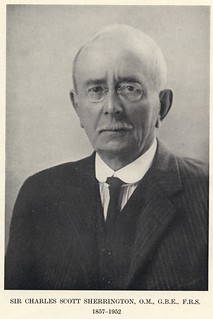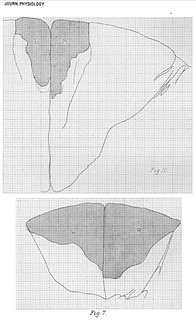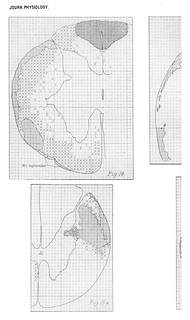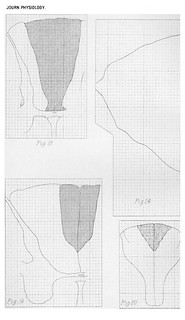- Creation
-
Creators (Definite): Sir Charles Scott Sherrington; The Cambridge Engraving CompanyDate: 1893
- Current Holder(s)
-
- No links match your filters. Clear Filters
-
Cited by
 C.S. Sherrington, 'Note on the Spinal portion of some Ascending Degenerations', Journal of Physiology 14 (4-5) (1893), pp. 255-302.
C.S. Sherrington, 'Note on the Spinal portion of some Ascending Degenerations', Journal of Physiology 14 (4-5) (1893), pp. 255-302.
Description:Fig. 5 in text:'Level close above the pyramidal decussation; lower end of the nucleus hypoglossi. (Fig. 5.) The main degreneration, that in the funic. cuneatus, still presents the same general features as before. Although occupying nearly as wide a portion of the surface, it has become separated from] the middle line by three times as great a distance as before. It extends much more deeply into the grey matter here than lower down. At this level grey mnatter pervades the deeper portion of the funiculus in scattered masses.' (258)
Fig. 6 in text:
'Immediately below the point at which the central canal opens into the floor of the lVth ventricle and where the central grey matter has already come well to the surface the degeneration has the following extent. (Fig. 6.)' (259)
Fig. 11 in text:
'The distribution of that portion of the white matter still completely sound, in which at least no degeneration has been detected by myself after search in a large series of specimens is a matter of some interest. Its details can be gathered from Fig. 11. Part of it is that portion of the white matter of the deep part of the lateral column which lies between the dorsal edge of the lateral horn of grey matter and the ventral limb of the substantia gelatinosa of the posterior horn, and a small area abutting laterally on the above. Part of it is the portion of the lateral column abutting on the lateral edge of the grey matter of the anterior horn; part of it the portion of the anterior column abutting on the mesial edge of the anterior horn.' (273-274)
Fig. 12 in text:
'In the middle of the field of scattered degeneration there is however in each posterior column a considerable islet of very severe or almost absolute degeneration. The topographical relations are seen in analysis Fig. 12. If the area of the posterior columns be 636 then of this 411 is occupied by absolute degeneration. In 11 squares no signs of degeneration are detectable, all these eleven squares abut on the grey cornua.' (275)
-
Cited by
 T. Quick, 'Disciplining Physiological Psychology: Cinematographs as Epistemic Devices, 1897-1922', Science in Context 30 (4), pp. 423-474.
T. Quick, 'Disciplining Physiological Psychology: Cinematographs as Epistemic Devices, 1897-1922', Science in Context 30 (4), pp. 423-474.
Description:'the mode in which Sherrington presented his work owed as much to the formulae, tables and calculations of the Cavendish physicists as it did to the anatomic accuracy of his Cambridge mentors. Rather than present lavish illustrations of his nerve investigations, as had Gaskell, Sherrington supplied tables of response measurements, graphs of reaction-intensities, and introduced grids with which he might reduce the complexity of nervous anatomy (fig. 1).'
'Figs. 1 (left) and 2 (right): Left: part of plate XIV from Sherrington 1893). Right: plate VII from Sherrington 1894.'














